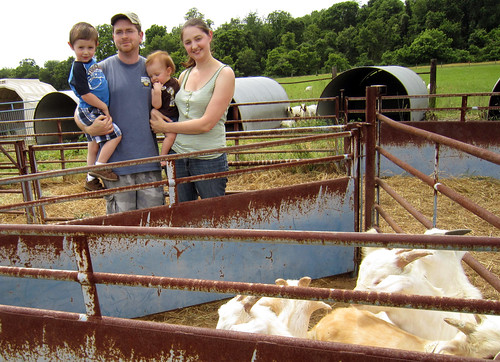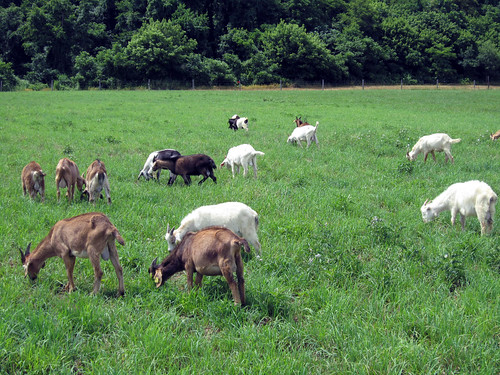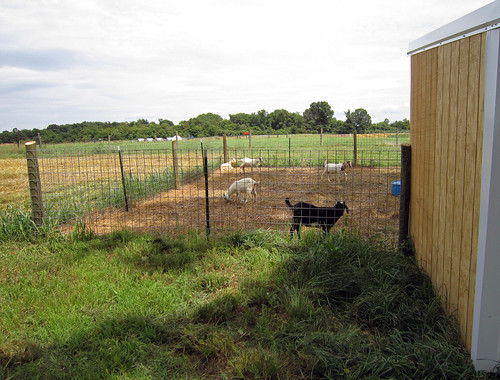For the first 14 days of the test, the goats essentially maintained their weight. Weight gain (loss) ranged from -9 to +7 lbs. among the 80 goats and averaged +0.58 lbs. (1.3 kg). Average daily gain (ADG) was 0.04 lbs. per day (18.1 g/d).
The top-gaining goat for the period was a Savanna x Spanish buck consigned by Janet & Stephen Garrett (Virginia). It gained 7 lbs. or 0.54 lbs. per day. One of Mike and Lorie Renick's (West Virginia) Kiko bucks gained 5 lbs. or 0.38 lbs. per day.
FAMACHA© and dag scores improved considerably from two weeks ago. FAMACHA© scores ranged from 1 to 3 and averaged 1.74, compared to 2.11 on June 10. No goats required anthelmintic treatment. This was expected as the goats were dewormed with two anthelmintics on June 10.
The improvement in FAMACHA© scores, especially in individual goats, would indicate that the double-deworming was effective. Fecal egg counts from today will quantify the effectiveness of the double-deworming.
Scours
Dag scores ranged from 0 to 4 and averaged 0.65, compared to 0.89 on June 10. Many of the goats with positive dag scores had dry feces, which indicates that they are over their scouring (diarrhea). There were only a few new cases of scouring.
Unless it has an infectious or parasitic cause, scours are usually self-limiting and will go away without treatment. They are most likely a result of stress and adaptation to a new diet. The consistency of the feces is also affected by the moisture in the forage.
Body condition scores improved slightly, especially among individual goats, while coat condition scores remained the same. Coat condition was difficult to assess due to the goats' wet coats. It rained before the goats were worked.
Good grazing
Pasture conditions are good. After working, the goats were given access to two acres of cool season grasses, a mostly "clean" pasture that has not been grazed since last summer.
The pearl millet is coming up nicely. The chicory field was recently mowed and should have adequate moisture to re-grow. Last year, due to the drought, the two-acre chicory paddock was never able to rebound after being mowed prior to the start of the test, whereas the pearl millet provide several weeks of valuable grazing.
This year's test has additional two and a half acres of pasture available for grazing. The pasture consists of cool season grasses amongst tree plantings: walnut trees and mixed hardwoods. This will be the pasture of choice if/when the test experiences prolonged periods of extremely, hot humid weather.
Penned goats
The goats in the pen enjoy good comfort under a tree and in their well-ventilated shelter. However, they've depleted their pen of grass and probably long for some green vegetation. They have free access to hay and are fed grain (pellets) in the evening: as much as they'll eat in a 20-minute period.
The data collected on the penned goats was similar to the goats in the pasture test. Weight gain (loss) ranged from -5 to + 5 lbs. and averaged -0.4 lbs. (0.88 kg). Average daily gain was -0.03 lbs. per day (13.6 g/d). So far, the weights of the penned goats have varied widely. Weight gain seemed unrealistically high (+6 lbs.) during the six-day adjustment period, whereas the goats' failure to gain weight in the previous 13-day period is perplexing.
FAMACHA© and body condition scores were similar to the goats in the pasture test. The penned goats have had less problems with scouring. The goats are cleaner and more docile.
The goats will be worked next on July 7. In addition to the usual work, a pooled fecal sample will be collected. The test still awaits the results of the first fecal coproculture.
Download June 23 report
The top-gaining goat for the period was a Savanna x Spanish buck consigned by Janet & Stephen Garrett (Virginia). It gained 7 lbs. or 0.54 lbs. per day. One of Mike and Lorie Renick's (West Virginia) Kiko bucks gained 5 lbs. or 0.38 lbs. per day.
 |
| Mike and Lorie Renick from West Virginia |
FAMACHA© and dag scores improved considerably from two weeks ago. FAMACHA© scores ranged from 1 to 3 and averaged 1.74, compared to 2.11 on June 10. No goats required anthelmintic treatment. This was expected as the goats were dewormed with two anthelmintics on June 10.
The improvement in FAMACHA© scores, especially in individual goats, would indicate that the double-deworming was effective. Fecal egg counts from today will quantify the effectiveness of the double-deworming.
Scours
Dag scores ranged from 0 to 4 and averaged 0.65, compared to 0.89 on June 10. Many of the goats with positive dag scores had dry feces, which indicates that they are over their scouring (diarrhea). There were only a few new cases of scouring.
Unless it has an infectious or parasitic cause, scours are usually self-limiting and will go away without treatment. They are most likely a result of stress and adaptation to a new diet. The consistency of the feces is also affected by the moisture in the forage.
Body condition scores improved slightly, especially among individual goats, while coat condition scores remained the same. Coat condition was difficult to assess due to the goats' wet coats. It rained before the goats were worked.
 |
| Good grazing conditions |
Good grazing
Pasture conditions are good. After working, the goats were given access to two acres of cool season grasses, a mostly "clean" pasture that has not been grazed since last summer.
The pearl millet is coming up nicely. The chicory field was recently mowed and should have adequate moisture to re-grow. Last year, due to the drought, the two-acre chicory paddock was never able to rebound after being mowed prior to the start of the test, whereas the pearl millet provide several weeks of valuable grazing.
This year's test has additional two and a half acres of pasture available for grazing. The pasture consists of cool season grasses amongst tree plantings: walnut trees and mixed hardwoods. This will be the pasture of choice if/when the test experiences prolonged periods of extremely, hot humid weather.
Penned goats
The goats in the pen enjoy good comfort under a tree and in their well-ventilated shelter. However, they've depleted their pen of grass and probably long for some green vegetation. They have free access to hay and are fed grain (pellets) in the evening: as much as they'll eat in a 20-minute period.
 |
| A contrast of production systems: pen vs. pasture |
The data collected on the penned goats was similar to the goats in the pasture test. Weight gain (loss) ranged from -5 to + 5 lbs. and averaged -0.4 lbs. (0.88 kg). Average daily gain was -0.03 lbs. per day (13.6 g/d). So far, the weights of the penned goats have varied widely. Weight gain seemed unrealistically high (+6 lbs.) during the six-day adjustment period, whereas the goats' failure to gain weight in the previous 13-day period is perplexing.
FAMACHA© and body condition scores were similar to the goats in the pasture test. The penned goats have had less problems with scouring. The goats are cleaner and more docile.
The goats will be worked next on July 7. In addition to the usual work, a pooled fecal sample will be collected. The test still awaits the results of the first fecal coproculture.
Download June 23 report











